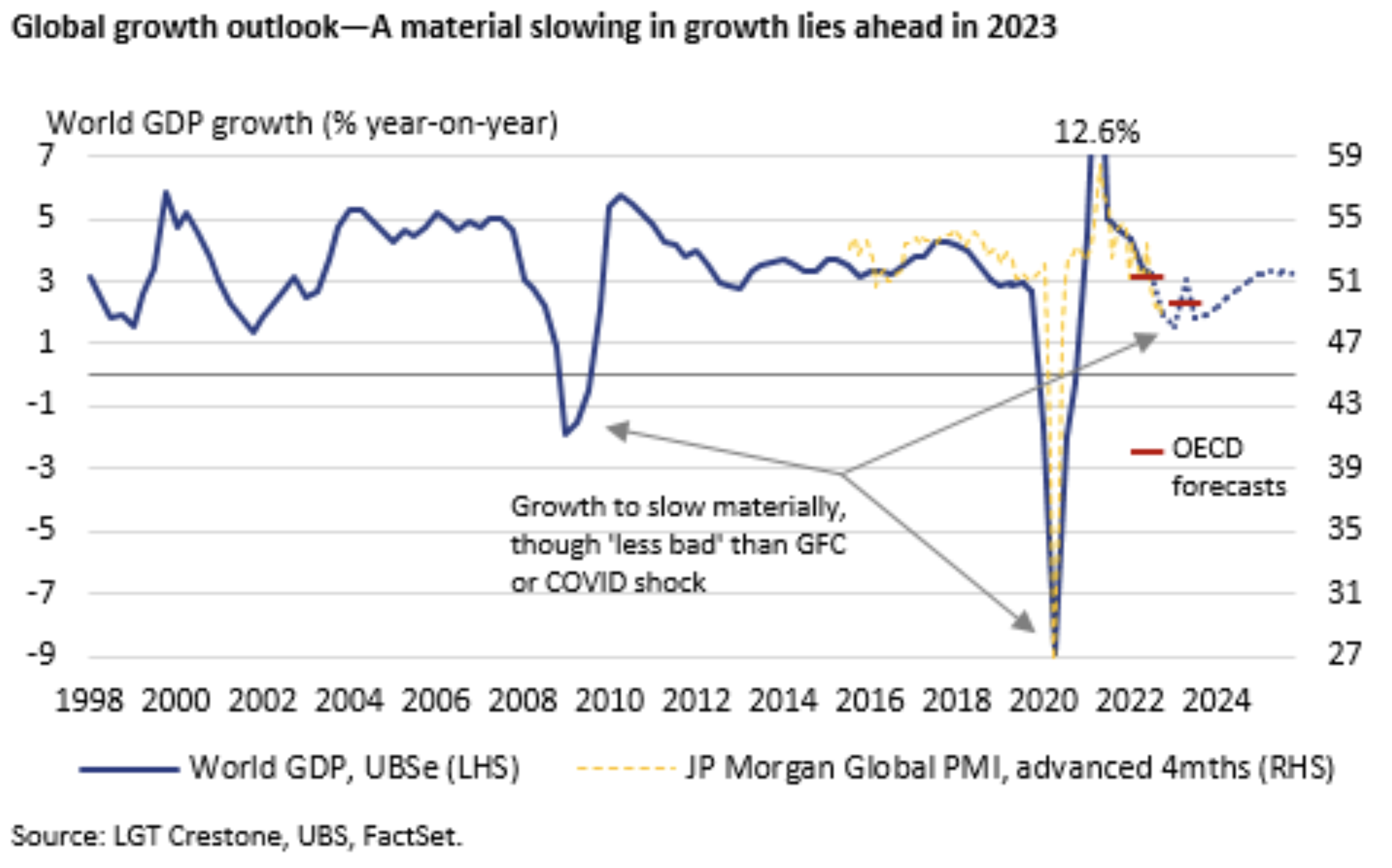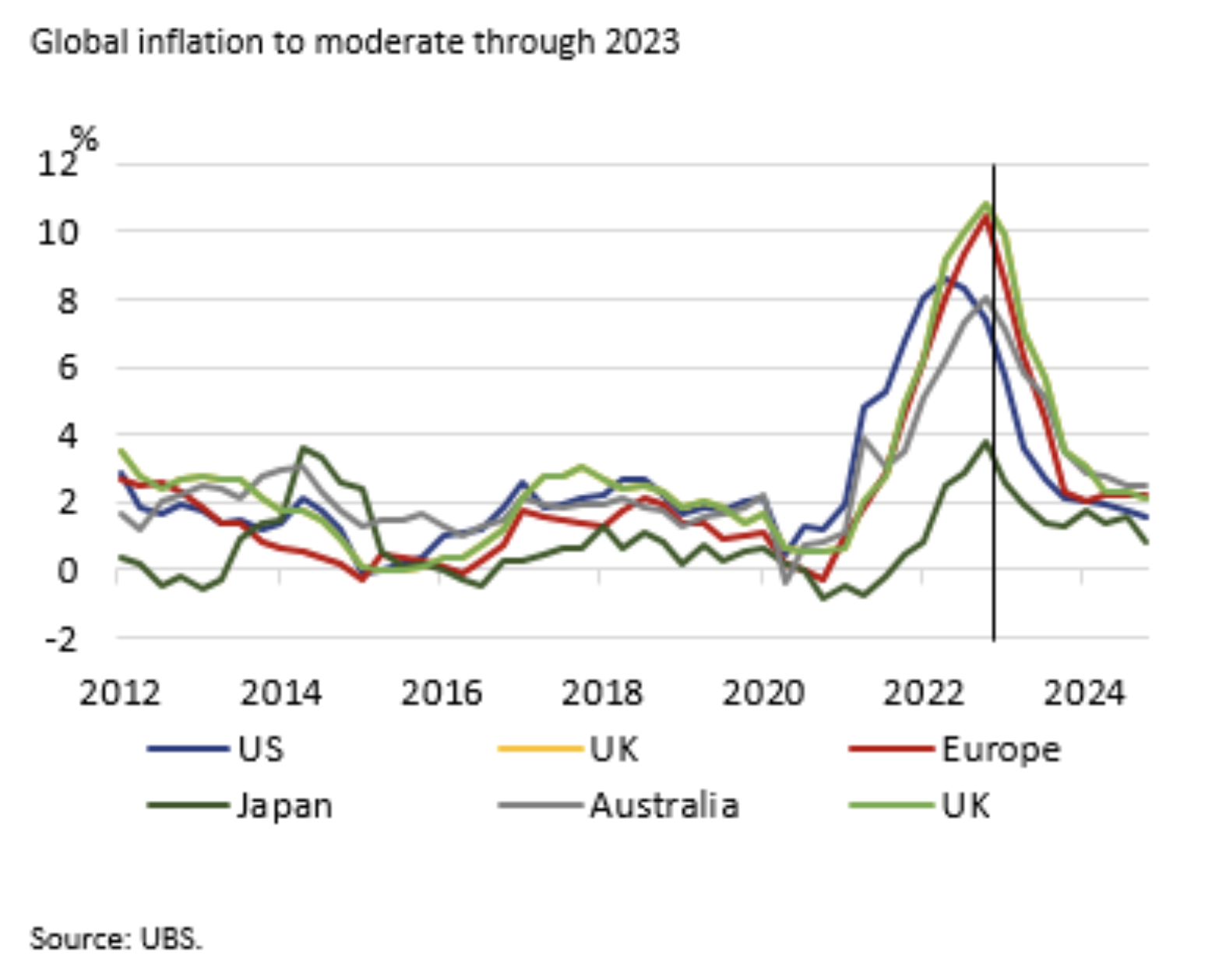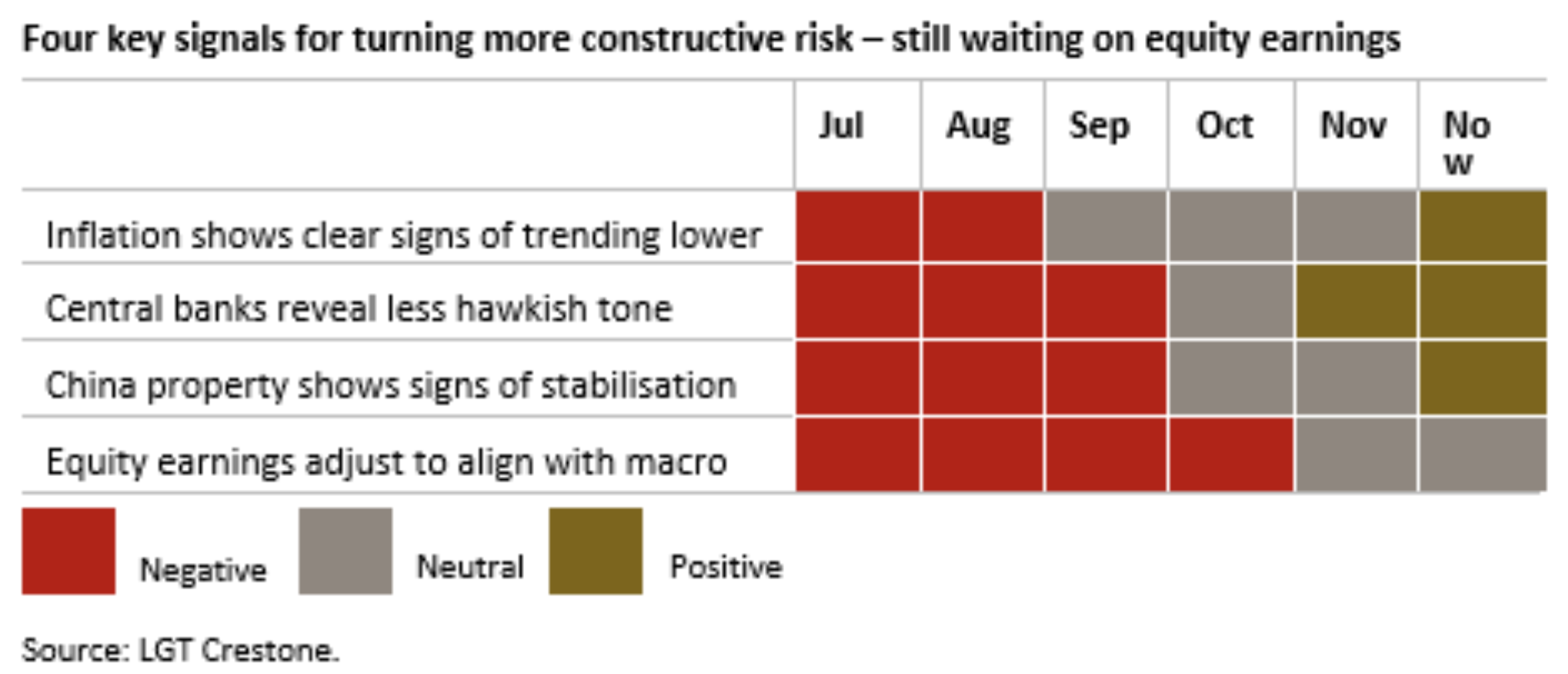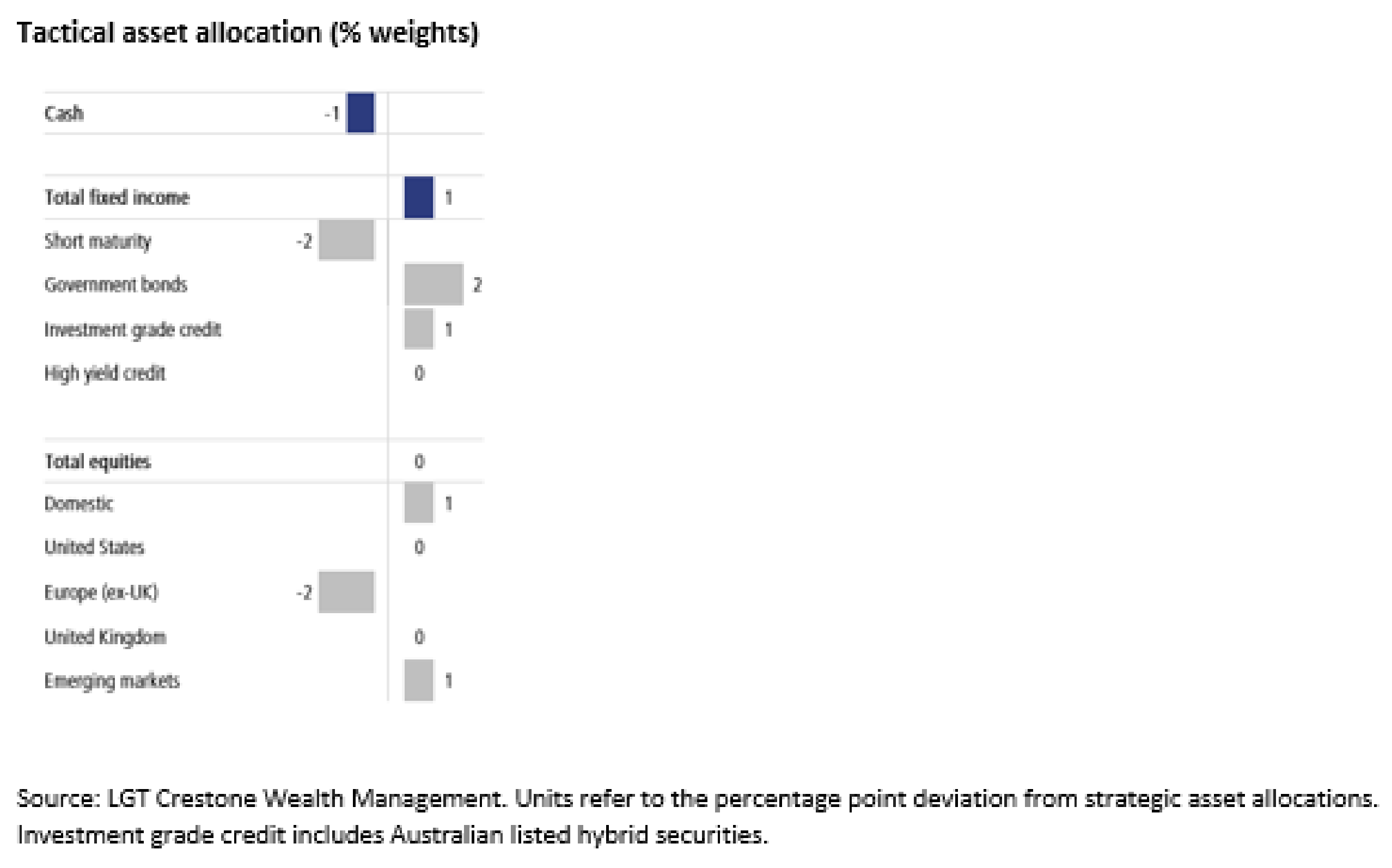Outlook for 2023: Worse macro, better markets
Change and volatility have dominated the macro environment in 2022. But despite the prospect of a material slowing in global growth and elevated inflation and interest rates, 2023 has the potential to reveal a more stable market backdrop. Much of the painful valuation adjustment journey across bonds and equities will reside in 2022. We continue to favour allocations to income opportunities and alternative investments. For equities, we are staying focused on quality, favouring defensive sectors and some non-US regions. Further disinflation and earnings adjustments could lead us to upweight equities during H1 2023.
2022’s regime change delivered a difficult year for economies and markets
Looking back, 2022 has proved to be a year of significant volatility and change in the economic landscape. Central banks were found to be well behind the curve in withdrawing their uber-low interest rate stimulus which, in tandem with an unanticipated (and now prolonged) Russia/Ukraine war, unleashed a significant uplift in demand- and supply-led inflation in just about every corner of the globe.
Multi-decade high inflation led central banks to embark on the most aggressive tightening of policy since the early 1980s. This portends, with the usual lags of policy, a material slowing in world growth in 2023. But that demand destruction will ultimately see inflation slow and interest rates peak too.
This ‘regime change’ was also reflected in a difficult year for financial markets and portfolio returns. The rapid rise in interest rates underpinned a sharp reassessment of valuations, with listed equities and fixed income returns, domestically and offshore, experiencing double-digit declines in the first half of the year (and with little progress thereafter). Indeed, for the US, it now seems highly likely that 2022 will only be the third year since 1926 (the others being 1931 and 1969) that equity and bond returns have both been negative. Alternative assets have been one of the few, if only, places to shelter. Thankfully also, there have never been two consecutive years where US bond and stock returns were negative.
“Bear markets reveal bad investments made during bull markets...
…bull markets reveal good investments made during bear markets.”
Author unknown
Macro to get worse in 2023, but peak rates and easing inflation come into view
There is little doubt that published measures of growth will deteriorate significantly as we traverse H1 2023. Financial conditions have tightened sharply, consumers’ excess saving balances will dwindle in the face of rising energy and debt servicing costs (despite support from rising wage growth), business’ capex plans will wane, and unemployment will rise.
Yet, as 2022 draws to a close, developments in recent weeks have challenged the view that the task of reversing inflation without a deep global recession is insurmountable:
- Inflation pressures are peaking—US inflation has peaked, easing from 9.1% in June to 7.7% in October, while upstream producer prices confirm this downtrend should continue in H1 2023. Moreover, while supply-chain pressures have eased in H2 2022, there is now clearer evidence weaker demand is weighing on services prices as well. Still high inflation in Europe, the UK, and Australia should also peak around year-end.
- Central banks will pause hiking in or around Q1 2023—Interest rates globally have already risen sharply in 2022. The well-understood lags between hikes and slowing growth argue that central banks should pause to assess the impact. Over the past few months, the US Federal Reserve (Fed) has joined other central banks in Europe, Canada, and Australia to indicate that this is likely. The recent peaking of US inflation suggests this is probable. In early February, we expect the Fed, now at 4.0%, to signal a pause at around 5%, and the Reserve Bank of Australia (RBA), now at 2.85%, to signal a pause at 3.35%. European and UK central banks will likely pause during Q2. We don’t expect policy to be eased before late 2023, as inflation (while falling) proves sticky.
- China has signalled moderately easier COVID and property policy—In November, China eased and refined its COVID restrictions, while also easing policy around the property sector to provide credit support. Recent outbreaks add near-term uncertainty, but the direction of policy remains clear. This should aid further easing of supply-chain pressures, while supporting growth in Europe, Asia, and Australia during 2023.
“2022 witnessed remarkable synchronicity of monetary policy rate hikes…We expect central bank policy rate paths to start to diverge over the coming quarters, with some ending, or at least pausing, tightening, while others march on for some time yet.”
Société Générale, November 2022
Global growth outlook—A material slowing in growth lies ahead in 2023

Forecasts by both UBS and the Organization for Economic Development (OECD) suggest the world economy will slow to about 2% growth in 2023 (from 3.2% in 2022), before UBS sees a modest pick-up to 2.7% in 2024 (see chart above). This suggests the world will be in a mild recession, or thereabouts, over the coming year (albeit without the loss of activity evident in the GFC or pandemic).
However, there will be more macro divergence than in the recent past. We expect the US economy to slow to around ‘flat’ growth in mid-2023, but narrowly avoid recession. Less positively, the UK is likely already in a recession, and Europe will be in one by the end of its winter. More positively, Asia and Australia will slow to ‘half speed’ but avoid recession this cycle. Strength in the US dollar is expected to fade through 2023, as the Fed peaks, a better 2024 global growth outlook comes into view, and energy prices ease. The Australian dollar is seen pushing through USD0.70.

Much of the painful valuation adjustment journey across bonds and equities will reside in 2022, we continue to favour allocations to income and alternatives, while further earnings adjustments could lead us to up-weight equities during H1 2023.
Three out of four signals suggest a more constructive outlook for 2023 and 2024
Portfolios should benefit from adding some duration in H1 2023 by allocating to fixed-rate assets. This is before the RBA is expected to slow the increase in interest rates or lower rates later in 2023.
We have maintained a relatively defensive portfolio position through 2022, closing our overweight to equities in January, and moving progressively more in favour of fixed income through the year as central banks lifted interest rates. Outcomes for 2023 will largely be conditioned by the pace at which inflation peaks and central banks pause, so as to minimise the future impact on economic growth, unemployment, and earnings.
With growth slowing, and elevated inflation and interest rates, it remains a challenging near-term backdrop for equities. However, we should be wary of extrapolating the lagged impacts of 2022’s policy tightening (the valuation adjustment) onto market outcomes for 2023, since a significant correction has already played out during 2022. We believe a significant amount of the macro journey of rising rates is now in the past. However, more earnings adjustment (to be in line with the macro) still lies ahead. It will be key to assess if and when a sufficient adjustment has occurred to warrant a positive inflection during 2023.
For equities, three of our four signals for becoming more constructive have recently turned from amber to ‘green’. While price/earnings (P/E) valuations have returned to ‘fair’, earnings still appear too high relative to the macro outlook and long-term trend. This suggests near-term caution for now. However, as discussed in the equities outlook (below) further adjustments in earnings in the coming reporting season could see equities more confidently trough through Q1 2023 ahead of a modest recovery during H2 2023.
For fixed income, history suggests bond yields peak one to four months before the peak in the US Fed rate. As we expect this to be during Q1 2023, this supports our recently more positive outlook on both bonds and credit.
For alternatives, hedge funds, real assets, and private debt remain well positioned to provide a near-term defence. In private markets, as with public equities, a company earning adjustments, combined with the further potential for lagged revaluations due to higher interest rates, will be important to monitor.

“US 10-year Treasury yields typically peak within a 0–4-month window of the last Fed rate hike for the cycle, which could be as early as now or as late as the end of March 2023.”
BCA Research November 2022
Tactical asset allocation—Position for a peak in rates
In this month’s 2023 outlook, we have made some tactical asset allocation changes to position for the year ahead:
- We have reduced cash from +2 to -1 to reflect an improving investment outlook, and a more favourable view toward fixed income returns for the year ahead.
- We add to credit. We have maintained our current +2 overweight to government bonds but add to both investment grade (from 0 to +1) and high yield (from -2 to 0) credit. While we expect a default cycle and pressure on spreads to widen, we see investors as now adequately compensated through elevated yields.
- We maintain our neutral equities position. However, given a likely peak in the US dollar, valuations now appear compelling in emerging markets. Reflecting this, we trim our overweight to Australia (+2 to +1), reallocating to emerging markets (0 to +1).
While we remain defensively positioned at the start of 2023, staying overweight fixed income relative to equities, we have now put some additional cash to work in credit to recognise an imminent peak in policy tightening. Should inflation continue to moderate, and equity earnings rebase, we will look to reallocate toward equities through H1 2023.
The key headwinds to a more constructive outlook on equities remains renewed concerns about the inflation and rates outlook, as well as a broadening of geo-political risks, that point to an ongoing adjustment lower in the equity earnings outlook through 2023.

Fixed income—We expect positive returns in 2023
Duration risk has largely been removed: For most of 2022, we witnessed bond yields rise and credit spreads widen to incorporate the aggressive hiking cycle from global central banks in response to rising inflation. Most fixed income asset classes, which had a level of duration at the start of the year, would have shown negative returns due to the speed of central bank rate hikes, aimed at curbing inflation. For 2023. we are expecting a much better environment for investors seeking returns from this defensive asset class.
Bond yields should rally as central banks pause: Our base case scenario is that markets have all but priced in the future rate rises expected in Q1 2023. Economic data is showing that demand is weakening, a likely precursor to reduced corporate pricing power over the coming year. With signs that inflation has peaked, we believe central banks will continue to tighten, but at a much slower pace. And we anticipate the Fed will signal a pause in Q1 2023. As growth slows in Australia and the US, we expect to see some fall in bond yields and short-term money market rates in 2023, particularly at the front end of the curve (between one and five years). We also expect some negative moves in the UK and Europe.
Fixed income should provide return and income in 2023: Given interest rates are now much higher than during quantitative easing, we believe the risk-return to the asset class has been restored. While we expect volatility to continue into 2023, especially in global equities, fixed income should provide a level of return and income for investors. Our preference is for portfolios to increase duration over 2023 via high-grade government bonds and investment grade credit. Investors should be highly selective within high yield credit, despite the attractive yields, as the cycle is likely to see an increase in defaults to more normalised levels and higher refinancing costs to weaker rated corporates.
Domestically, the banks will continue to issue senior unsecured notes for their wholesale funding requirements and the repayment of AUD 188 billion they borrowed from the RBA via the Term Funding Facility. The major banks will also need to continue to issue subordinated Tier II bonds, which will keep spreads elevated in this sector, but will likely return over 7.00% for the year as we expect interest rates to come down and the yield and credit curve to steepen once again. We expect a lower pipeline of Additional Tier I hybrid supply in 2023. However, with hybrid issues pricing tighter in the Australian market versus offshore and relative to subordinated Tier II, we may see some issuers taking advantage of the tighter spreads and consider further hybrid issuance in 2023.
Equities—Macro was the topic de jour for 2022…in 2023, it will all be about earnings
We have turned more constructive on emerging market equities. With US dollar strength likely closer to a peak than a trough, the risk-reward trade-off looks more attractive from a macro perspective for emerging markets than it has looked for some time.
We have turned more constructive on emerging market equities. With US dollar strength likely closer to a peak than a trough, the risk-reward trade-off looks more attractive from a macro perspective for emerging markets than it has looked for some time.
Global markets to re-base lower before possibly having a stronger H2 2023: The lagged impacts of almost 500 basis points (bps) of rate increases are yet to be reflected in corporate earnings. The MSCI World index is trading at a 12-month forward P/E of 15.7x. Although this is well off the 21x it traded at in the early part of 2021, it is worth noting that this level is only one point from the prior decade peak. Furthermore, the competitiveness of fixed income as an asset class is likely to remain a headwind for equity flows, since we believe interest rates are likely to be structurally higher relative to the past decade.
Equity markets are yet to reflect a material macro slowdown: To date, this year’s fall in equity markets appears to have been largely driven by a fundamental revaluation due to sharply higher interest rates. Despite this, markets have not yet become ‘cheap’ in an historical context, and appear unprepared for major earnings disappointments. This leaves considerable downside risk in place near term, ahead of some further adjustments in earnings in the months ahead.
Significant price adjustment already in the past, but stay cautious: Despite our near-term caution, we are cognisant that once equity markets fall 25%, forward-looking returns (i.e., greater than one year) are typically positive. In light of this, the view as we enter 2023 can be best characterised as positioning cautiously (for now) but thinking constructively.
Regionally, Australia is a relative outperformer: Australia’s corporate earnings will likely be relatively resilient. The bottom-up consensus outlook is for 2% earnings-per-share (EPS) growth for the S&P/ASX 200 in both the 12 months to June 2023 and June 2024. Anaemic growth rates like this are consistent with a ‘soft landing’ for corporate profits, likely supported by a ‘less bad’ macro backdrop. Combined with a 4.5% dividend yield (the second highest in developed markets), a modicum of EPS momentum and less upside pressure on discount rates should mean domestic equities post positive gains in 2023.
We have moved overweight emerging market equities: Emerging markets were one of the worst performing markets in 2022. We turn more constructive. Equity managers are very underweight and at 11.3x P/E multiples, valuations are screening less onerous than other parts of the world. China is making tentative steps towards a more pragmatic approach to COVID-zero, and there has been greater policy support for its beleaguered economy. Recent outbreaks add uncertainty, but the more positive direction of policy is clear. With the US dollar likely closer to a peak than a trough, the risk-reward looks more attractive from a macro perspective for emerging markets than it has looked for some time.
Within private markets, history tells us that vintage years following periods such as the one we are currently working through, tend to be some of the best performing, and we have already seen meaningful declines in valuations.
Alternatives—Real assets remain preferred, while volatility will support hedge funds
2022 proved a strong testing ground for alternative assets and while we expect this test to continue through 2023, the return outlook arguably looks more attractive, given a meaningful recalibration in broad valuations and long-term interest rate expectations.
Heightened volatility should continue to provide a ripe hunting ground for diversified hedge fund programs and offer strong risk-adjusted returns into 2023. At a strategy level, we expect discretionary macro strategies to continue their renaissance, given ongoing geopolitical uncertainty. Idiosyncratic credit-orientated strategies could excel, given current and ongoing dislocations in credit markets. We still caution against high-beta, equity-orientated strategies, but market neutral may benefit from more focus on earnings in the year ahead.
Further valuation impacts are likely still to be felt within private markets, so we are not deploying heavily into fully-invested strategies at this juncture. However, history tells us that vintage years following periods such as the one we are currently working through, tend to be some of the best performing, and we have already seen meaningful declines in valuations. We are, therefore, encouraging deployment into new primary and secondary opportunities across both private equity and venture capital through 2023.
Higher-quality property and infrastructure have fared particularly well in 2022 and we expect this to continue through 2023. Many of these assets have embedded inflation linkages and/or are able to increase net operating income, which can and has played a significant role in offsetting the impact of rising interest rates on valuations. We continue to focus on more defensive assets to act as a further portfolio ballast to public and private equity positions. However, we anticipate that the time for more opportunistic investments in the space may not be too far away.
The transition to a net-zero economy as a long-term structural investment theme only continues to grow in relevance for portfolios. Gaining exposure through private markets and/or real assets presents a significant growth opportunity, while also diversifying risk away from industries and assets that may fail to adapt and thus threaten portfolio returns.
Learn what LGT Crestone can do for your portfolio
With access to an unrivalled network of strategic partners and specialist investment managers, LGT Crestone offers one of the most comprehensive and global product and service offerings in Australian wealth management.
Click 'CONTACT' to find out more.
2 topics

